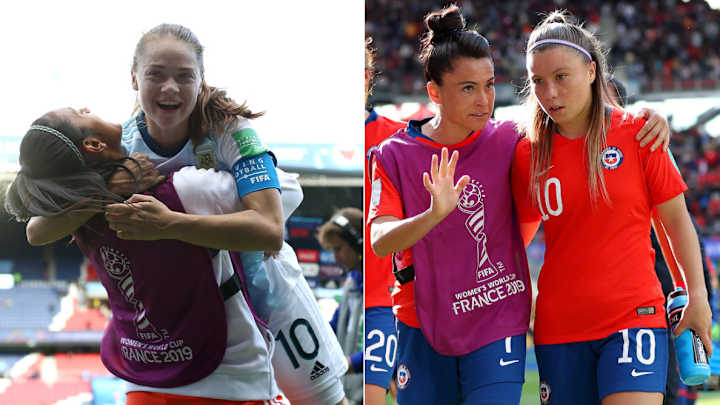Women's World Cup Challenges for Argentina, Chile Hardly Compare to Fights at Home

Earlier this week, when Argentina earned its first point ever at a Women’s World Cup thanks to a valiant 0-0 draw against 2011 champion and 2015 runner-up Japan, the players, upon hearing the final whistle, fell to the ground, celebrating as if they had just achieved the unthinkable.
A day later, as rain and thunder played a central role, Chile–playing its first Women's World Cup–worked tirelessly for a result against ninth ranked Sweden. The Chileans stifled the reigning Olympic silver medalists, and it seemed as if another improbable stalemate was unfolding, but the Swedes broke through late against otherwise stellar goalkeeper Christiane Endler to win 2-0.
Now, the mountain becomes even taller for both South American sides, as Argentina faces England on Friday and Chile faces the daunting task of taming the prolific USA, each knowing that chances of progressing to the knockout stage remain slim. But the simple truth is that no game or opponent at this competition will be more difficult and trying than the obstacles they have had to face just to make it to France.
While their male counterparts both vie to reach the Copa America final for a third straight time, the juxtaposition with the women's battle at home for respect, equality, funding and basic support is astounding. Against the backdrop of machista culture that exists throughout the continent, Argentina and Chile's women's programs have fought back and created a revolution in order to make themselves counted.
When FIFA removed these teams from its women's world rankings in 2016 due to inactivity–as a result of lack of support from their respective federations–the players started a movement. From creating their own unions to marches on the streets, Argentina and Chile birthed a new narrative for their squads, one that would eventually take them to the World Cup stage.
Let’s begin with Argentina. In 2017, after the AFA rejected a written demand of better travel and working standards (including a daily payment of $8.50 for training) the women’s team realized that its call to action was actually part of a bigger problem, and so it joined the #NiUnaMenos (Not one [woman] less) movement in order to not just fight against pay and working inequality but issues of domestic abuse and violence against all women in South America. Eventually, the financial issues of sports, social aggression and disregard for all women in the country gained international attention and added so much pressure that the federation was forced to act. Earlier this year, it announced the start of the first professional league and a promise to provide fields and even build a high-quality training center. The federation will also provide funds toward professional contracts for at least eight players for all 16 clubs. The contract, however, is about $330 per month.
A year before Argentina’s women began the fight against their federation, Chile built a union. Thanks to players such as former star Iona Rothfeld (who is still involved as a director) and Endler, the National Association of Female Footballers was born in order to not just assess the standards of the national team, but also of clubs and female players throughout the country.
“The main idea was just to make the authorities grab the responsibility they hadn't grabbed in many, many years. So this association, the thing that we wanted to put out there was that we were being treated differently just because we were women,” Rothfeld recently told CNN.
This union eventually merged with the men’s own organization, and thanks to that partnership, Chile’s federation agreed to host the Copa America Femenina, the only route for South American teams to qualify for the Women’s World Cup, the Olympics and the Pan-American Games. Brazil won last year’s tournament, while Chile ended runner-up and Argentina in third.
After 13-0, what can we expect from the #USA vs. #CHI in it's next match at the #FIFAWWC? @GrantWahl breaks it down on this week's Planet Fútbol TV.
— SI Soccer (@si_soccer) June 14, 2019
For more Women's World Cup analysis and a look ahead to Copa America, watch with a FREE SI TV trial https://t.co/XusHz3R5FO pic.twitter.com/szeHffIpIh
Argentina and Chile are only two examples of what female players in the continent have to do in order to be respected as professionals, and the fight will continue after the Women's World Cup ends. From sexism and a lack of federation support in Brazil to a lack of professional accommodations in Colombia and the continued absence of professional leagues in countries such as Peru and Bolivia and Venezuela, South America remains a place where the fight for female players is an ongoing theme.
So as Argentina and Chile prepare to face off against two title favorites, it’s important to remember what they had to do to get here–and most importantly, to acknowledge that their fight will go on well after the final whistle blows on their time in France.
